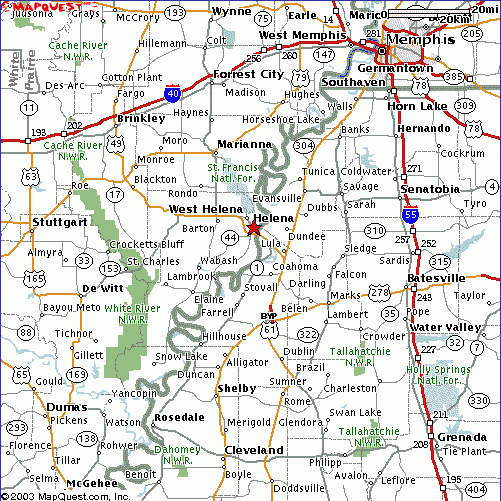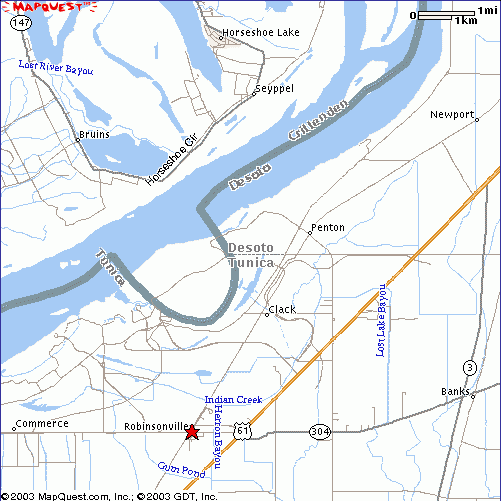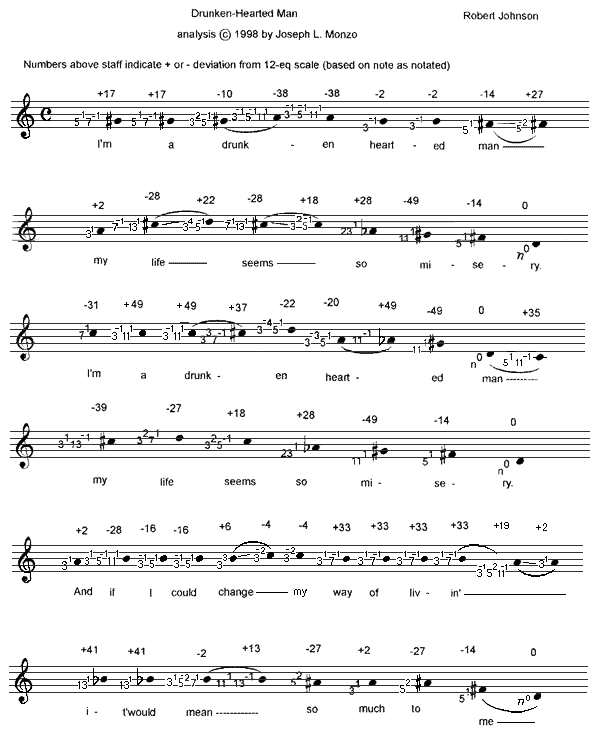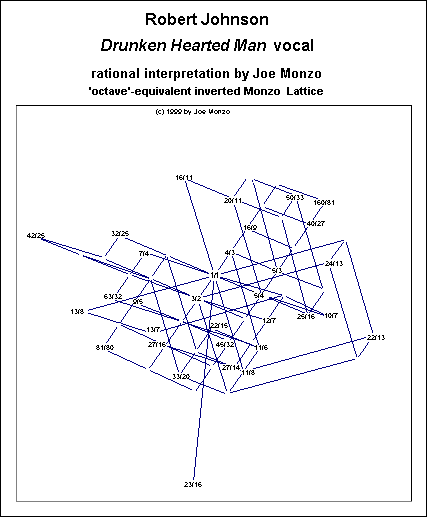Private lessons with Joseph Monzo are available online via Discord / WhatsApp / Skype: composition, music-theory, tuning-theory, piano, and all woodwinds (sax, clarinet, flute, bassoon, recorder). Current rates US$ 80 per hour (negotiable). Send an email to: monzojoe (AT) gmail.
A Microtonal Analysis of Robert Johnson's "Drunken Hearted Man"
© 1998 by Joseph L. Monzo
(This page is accompanied by a video file created with Tonescape, simulating one verse of Johnson's song. Watch the video from YouTube below.)
Tonescape video of the analysis presented on this page
Click here to download my files: download the Tonescape video (~119mb), download the mp3, or download the MIDI file The mp3 and MIDI are of my original analysis, done entirely by ear, and in terms of rhythm and pitch are more accurate to what Johnson actually sang and played.)
Background
Biography
Robert Johnson's music
Microtones in Johnson's music
Rational analysis of vocal from Drunken-Hearted Man
Appendix: Observation on the "Blue 3rd"
References
BACKGROUND
|
The blues style known as Delta Blues originated in the "juke joints" and parties on the country plantations and in the towns in the areas of Arkansas and Mississippi on either side of the Mississippi River south of Memphis, Tenessee, in the early years of the 20th century. Its origins are ackowledged to have developed mostly in the playing and singing of Charley Patton around 1912 or so. The generation following Patton saw the emergence of the man generally considered to be both the greatest of all Delta Blues musicians and truly a musical genius who ranks with the greatest of composers and performers, regardless of which style: Robert Johnson. |

|
BIOGRAPHY

|
There is still not a lot of detail known about Johnson's life. He was born in 1911 in Hazlehurst, in southern Mississippi, to Julia Dodds and Noah Johnson. Julia's husband, Charles Dodds, had escaped from a lynch mob and fled to Memphis and assumed the name Charles Spencer. In his absence Julia began living with Noah Johnson, with whom she gave birth to Robert. At a young age Robert ended up with his stepfather in Memphis for a few years, and adopted the name Robert Spencer. After his mother remarried to Dusty Willis, Robert then spent his adolesence with them during the 1920s in Robinsonville, Mississippi. He then learned of his real father and changed his name again, to Robert Johnson. |
By this time he had learned to play Jew's Harp and harmonica, and had just started on guitar. The great Delta Blues singer and guitarist Son House moved to Robinsonville, and Johnson was greatly impressed and influenced by him. He would follow House and Willie Brown at the gigs they did together and beg them to let him play. They would eventually give in, but then snatch the guitar away from him because his playing was so poor.
J Johnson married at 18, and both his wife and child died in childbirth. After this, he went back to Hazlehurst and married an older woman who took care of him while he studied with Ike Zinnerman (who never recorded). A year later, the couple moved to Robinsonville, and everyone was amazed at the incredible advance in Johnson's technique in such a short time. Rumor had it that he had sold his soul to the Devil to obtain his extraordinary ability, and Johnson's lyrics claiming partnership with Satan did nothing to contradict the stories.
He soon deserted his second wife and based himself in Helena, Arkansas. During the early 1930s he was constantly hitching rides or hopping freight trains, wandering all over the Delta and the South, and later as far as Detroit, Toronto and New York. It was the Great Depression, and he played anywhere he could make some money, including the street.
Johnson had women everywhere he went, and would frequently get into trouble by paying too much attention to an attached woman. This happened at his last gig, in 1938. After drinking from an opened bottle of whiskey containing poison, and surviving, he contracted pneumonia in his weakened condition and died at the age of 27.
Mack McCormack has researched Johnson's life and written what must be the most detailed biography possible, but it has yet to be published.
ROBERT JOHNSON'S MUSIC
Johnson recorded 29 songs, most with two existing takes, in two sessions, both in Texas: November 1936 in San Antonio and June 1937 in Dallas. He performed alone on every cut, singing, and playing steel-stringed acoustic guitar with a bottleneck slide on one finger of his left hand.
His first 78 rpm release, Terraplane Blues, became quite popular, but none of his subsequent releases would equal it in sales. Also, Johnson had died just a year before he would have had the opportunity to appear in John Hammond's "Spirituals to Swing" concert in New York's Carnegie Hall (Benny Goodman's appearance there made him the "King of Swing"). Without knowlege of Johnson's passing, Hammond had been seeking him.
He became somewhat forgotten, until in 1961 an LP of Johnson songs called King of the Delta Blues Singers was released. This exposed him to a new audience of blues fans who already knew Muddy Waters, Howlin' Wolf, and other electric blues performers who had migrated to Chicago from the Delta. His recording were loved particularly by a large number of white American and especially British listeners. As evidenced by the title of the album, Johnson posthumously received the recognition he deserved, and Eric Clapton (Cream's version of Crossroads) and the Rolling Stones (a handful of covers, most notably Love in Vain), among others, paid him homage as a musical ancestor of rock'n'roll. His sound can be heard to some degree in almost all of the popular music created in America since his time.
Recently, the 2-CD set of his entire recorded output has been digitally remastered and released, with a comprehensive booklet and complete lyrics enclosed.
Johnson stands out from other Delta musicians in that he learned not only personally from his local influences but also from an extraordinarily wide variety of styles on 78-rpm recordings, possibly including even Duke Ellington. As a result, his guitar playing exhibits a sophistication which made him capable of changing meters, riffing styles and tempos smoothly (many of his songs) or abruptly (Malted Milk Blues), as required by the moment, making his guitar almost like an orchestral commentary on the vocals.
His guitar parts have an astonishingly propulsive rhythmic drive, and in most of his songs they evoke to me the rhythms of the train. Eric Clapton said:
"it really shook me up because...he didn't seem concerned with appeal at all...it didn't obey the rules of time or harmony or anything -- he was just playing for himself."
Johnson plays with such a heavy beat that it sounds like the train rolling across the tracks (at various tempos) while he sings the blues to himself or to his travelling buddy. And those vocals are every bit as complex as the early singing and playing of Louis Armstrong, maybe even more so [on Armstrong, see Sims 1987]. (There's also an interesting parallel here with Harry Partch, who was also riding freight trains and composing pieces about it, at about this same time.)
With a completely independent bass line, two-part chording or high-string riffing, and expert vocals, it often seems as though there are two (or even three) performers on the records. Keith Richards wrote:
"...I was hearing two guitars, and it took a long time to actually realize he was doing it all by himself."
On gigs, he played any music that his audience would pay for, and this variety is reflected in his own recordings. Much of his subject-matter was also a variety of standard repertoire among his colleagues, such things as being broke, his woman leaving him, evil spirits, and rambling, and the majority of the songs contain sexual double entendre, which was very common -- two great examples are Terraplane, using a car as a metaphor for his woman, and Phonograph Blues, invoking a record-player in a similar manner. But Johnson also wrote and sang about much more personal material, such as impotence (in at least three songs, Dead Shrimp Blues, Milkcow's Calf Blues, and the great Stones in My Passway). Even the song analyzed here has a reference to a kind of non-sexual impotence in the second verse: "I can't see the reason why I can't leave these no-good womens alone".
The consensus about Johnson's recordings is that the best songs evoke emotions so powerful as to rarely be attained in musical performance. In particular, when he sang the common macho blues boast about being in league with the Devil, he made it sound so convincing that it's scary -- his masterpiece Hellhound On My Trail is the best of all, and If I Had Possession Over Judgment Day, Me And The Devil Blues, and Preaching Blues (Up Jumped The Devil) are almost as chilling.
MICROTONES IN JOHNSON'S MUSIC
In his book Deep Blues, Robert Palmer notes several times that a major characteristic of Delta Blues is the functional use of microtonal subtleties in the slide guitar parts and especially the vocals, and that mainly through Muddy Waters this art was transmitted to the electric Chicago Blues of the 1940s and 1950s.
To a great extent, the powerful emotional mood in Johnson's songs is a result of his masterful manipulation of microtonal intervals in his singing, and in Hellhound, in much of the guitar part. His voice could sound like a moan, whisper, yell, or trombone solo, with seemingly effortless ease -- unless he constricted his throat for an even stronger effect -- and the slide guitar parts could evoke the same. In a couple of songs, he sings about the wind howling, then the driving guitar rhythm suddenly stops for a moment, while Johnson slides up to a single note that can raise the hair on the back of your neck.
RATIONAL ANALYSIS OF VOCAL FROM DRUNKEN-HEARTED MAN
Drunken-Hearted Man is not one of Johnson's most notable songs. It's good, but not as great as the songs mentioned above. Peter Guralnick [Searching For Robert Johnson] says that it is clearly derivative of Lonnie Johnson, who was another very strong influence on Robert Johnson, and that it exhibits not much originality. I chose it because Johnson's singing of "it would mean" in the first line of take 1 jumped out at me as being so noticeably microtonal in what originally sounded like a 12-equal context in the rest of the vocal (and which turned out to be very microtonal after all). Johnson's greatest songs are permeated with even more striking microtonal inflection.
I have analyzed this first verse below, utilizing my JustMusic prime-factor notation. The other verses are somewhat different, but not much, and what I give here acts as a template or theme, upon which the other verses are variations, differing in their degree of similarity, mainly as a result of reflecting the meaning of the words. This is Johnson's standard procedure in all his songs.
It should be noted that in this song there is not much pitch-bending in the guitar part -- in fact, the slide is used mainly just to slide across a few frets, giving a 12-equal glissando. Thus, the guitar provides a strong 12ed2 background behind the largely just-intonation vocal part.
Here is my interpretation, accurate to the best of my ability (susceptible to further correction), of the ratios of the notes sung by Johnson in the first verse of take 1 of Drunken Hearted Man:
(listen to my MIDI sequence or mp3 of my analysis)
(+ and - values above the staff give deviation, in cents, from the 12ed2 notes used as the basis for the staff-notation)

Here are the rational pitches of Johnson's vocal portrayed on a tonal lattice diagram:

I've added to this lattice a number of vectors that go to missing pitches, so that the planes representing the various primes can be sketched in greater detail. I thinks this helps the eye to grasp the placement of all the elements within the complete set (i.e., all of the individual notes in the context of the entire verse).
I invite alternate interpretations of these pitches, either new ratios for my measured cents-values, or altogether new measurements of the pitches off the CD. Also, I'd be interested in any alternate methods of measuring this tuning, instead of rational; i.e., equal, meantone, etc. My goal is to get as accurate a representation as possible of the tuning of Johnson's actual vocal (and guitar playing).
And here is a graph of the pitches presented as a scale, with their cents values, where 0 to 1200 represent the central 'octave' of the melody (d to d'). The one note which Johnson sings which is higher than the high-D, the D 34 5-1 which slides upward into on the word "life" at the beginning of the second line of my score, is presented on this graph in the lower octave.

This was figured out first by ear on my "Rational Guitar": a guitar which has frets for the notes which have the proportions 16:20:21:22:23:24:25:27:28:30 starting from D n0[= 1/1 = 0.00 semitones]. It does not have frets for the proportion 22.5 (= 45), or for any other odd-numbered ratios above 23, nor for any of the notes rising as harmonic ratios above G 3-1 [= 4/3 = (G 2(5/12) - 2 cents) = 4.98 semitones] (except for those which coincide with the harmonics of D n0), thus it lacks the following notes:
| F# 34 | 81/64 | |
| G 3-1 | 4/3 | |
| G# 32 51 | 45/32 | |
| B 3-1 51 | 5/3 | |
| C+ 3-1 111 | 11/6 | |
Nor does it have frets for notes which would be harmonics of any other 12-Eq note, unless the entire guitar were retuned.
I then made a MIDI sequence of the 1st verse of the song (guitar and vocal parts), and played the CD along with it to check my pitch-bend values. Doing this by ear, even this way, is still quite difficult, and some of these ratios may be slightly off, but it is quite close to what Johnson actually sang. (I was, however, able to make the subtle tempo changes very accurate. I did not bother to work with these tempo changes in the Tonescape video linked at the top of this page.)
Because of this uncertainty, I tried to use the simplest and smallest-number ratios to represent the pitches I heard. I stayed mostly within the 13-Limit, except for what sounded clearly like Ab 23^1 [=23/16 =(Ab 2^(6/12) + 28 cents) = 6.28 Semitones], which he uses twice, towards the end of the second and fourth lines of my score.
[IMPORTANT NOTE: The Tonescape video at the top of this page had to use a 13-limit substitute for this particular note. This is because Tonescape has a limit of being able to incorporate up to 7 dimensions in a tuning, and the 2.3.5.7.11.13.23 subgroup which I employed in my analysis of the vocal part here already has 7 dimensions, but I needed another dimension to represent 12ed2 for the guitar part. So since this note (Ab 23^1) was the only one being used in the 23-dimension, I replaced it in Tonescape with a 7-limit note 2^-25 3^2 5^6 7^3, ratio 48234375:33554432, which is only ~0.004 cent lower than Ab 23^1) and thus audibly indistinguishable from it. This enabled the elimination of the 23-dimension to make room for the 12ed2-dimension.]
It is quite possible that Johnson may have actually used much higher-prime ratios than some of the ones I have chosen. Some of these possibilities will be explored later in this paper.
In the first line, when Johnson sings  , he begins on the
usual just "major 3rd" of
, he begins on the
usual just "major 3rd" of
51 [= 5/4 = (F# 2(4/12) - 14 cents) = 3.86 semitones],
then slides upward
to approximately 4.25 semitones. Although
5-2 [= 32/25 = (F# 2(4/12) + 27 cents) = 4.27 semitones] is a low-prime
utonal ratio which is very close to this,
the sustained sung note may actually be a higher-prime harmonic of the "D" chord which he is playing
on the guitar, in this case F# 411 [= 41/32 = (F# 2(4/12) + 29 cents) = 4.29 semitones].
The notes I labelled B 3-1 51 [= 5/3 = (B 2(9/12) - 16 cents) = 8.84 semitones]
 were the most problematical. They occur in only one place in each verse,
as a pair, and are quite short and difficult to hear clearly. Johnson
has just played a banjo-like riff on the D n0 chord on the guitar, then
starts a walk-down riff on F# 2(4/12), and sings
these two notes over the guitar's F 2(3/12) (which
goes to E 2(2/12), functioning as the 3-identity
of the "dominant chord" on A 2(7/12), as his vocals
become more clearly consonant with the guitar). It
didn't seem likely to me that
it would be a high-prime harmonic such as
3-1 411 [= 9.27 semitones], so there may be
another ratio, possibly of utonal derivation, that would describe it
better. This pair of notes I have described as B 3-1 51
may even be two different pitches.
were the most problematical. They occur in only one place in each verse,
as a pair, and are quite short and difficult to hear clearly. Johnson
has just played a banjo-like riff on the D n0 chord on the guitar, then
starts a walk-down riff on F# 2(4/12), and sings
these two notes over the guitar's F 2(3/12) (which
goes to E 2(2/12), functioning as the 3-identity
of the "dominant chord" on A 2(7/12), as his vocals
become more clearly consonant with the guitar). It
didn't seem likely to me that
it would be a high-prime harmonic such as
3-1 411 [= 9.27 semitones], so there may be
another ratio, possibly of utonal derivation, that would describe it
better. This pair of notes I have described as B 3-1 51
may even be two different pitches.
Most notable in Johnson's vocals are the sections I have labelled:
in the first line, 
And in the last line, 
and 
These are all very small intervals.
The glissando on  sounds like it could arise as a result of
Johnson singing the "just major 3rd" of 51 [= 5/4 =(F# 2(4/12) - 14 cents) = 3.86 semitones] then
sharpening it to compensate for the sharper pitch of the F# 2(4/12)
[= 4.00 semitones] which would appear on the guitar,
but he is playing only the C 2(10/12) : D n0 dyad
on the guitar (in other words, no F# 2(4/12)) at this point in the verse, and the vocal goes more
than a comma higher than even the 12-eq F# 2(4/12).
sounds like it could arise as a result of
Johnson singing the "just major 3rd" of 51 [= 5/4 =(F# 2(4/12) - 14 cents) = 3.86 semitones] then
sharpening it to compensate for the sharper pitch of the F# 2(4/12)
[= 4.00 semitones] which would appear on the guitar,
but he is playing only the C 2(10/12) : D n0 dyad
on the guitar (in other words, no F# 2(4/12)) at this point in the verse, and the vocal goes more
than a comma higher than even the 12-eq F# 2(4/12).
The C 3-2 [= 16/9 = (C 2(10/12) - 4 cents) = 9.96 semitones]
on  is less than 1½ cents lower than 2(7/12) 191
[= 9.98 semitones], the 19th harmonic of the dominant chord
built on A 2(7/12) [= 7.00 semitones]
which Johnson is playing on the guitar. Indeed, he may actually be
singing 2(7/12) 191, as I have argued that 191 is a ratio used in
the blues and rock (see the
program notes to my piece Hendrix Chord).
is less than 1½ cents lower than 2(7/12) 191
[= 9.98 semitones], the 19th harmonic of the dominant chord
built on A 2(7/12) [= 7.00 semitones]
which Johnson is playing on the guitar. Indeed, he may actually be
singing 2(7/12) 191, as I have argued that 191 is a ratio used in
the blues and rock (see the
program notes to my piece Hendrix Chord).
The most obviously microtonal moment in the whole song is the third example, the ratios he sings on "i-t'would mean". This was the first time I really noticed microtonality in Johnson's singing, and is the reason why I chose to analyze this song over some of his better ones.
What is striking is that the microtonal, rational relationships are integral to the template, which is used as a basis for the variations in the succeeding verses. Johnson's songs can be said to fit into a rather small number of groups or families, within which the individual songs have important but very subtle variations between each other, which is what differentiates them as different songs, but overall they are quite similar within any given family.
To a degree, all of Johnson's songs sound vaguely alike if one does not pay close attention to the microtones in the bottleneck guitar parts and especially in the vocals. Only by listening carefully to these pitches do the differences reveal themselves.
APPENDIX: OBSERVATION ON THE "BLUE 3rd"
A lot of musicians who have described the intonation of the blues have said that the "blue 3rd" lies approximately halfway between the minor and major thirds, which would normally be interpreted in the usual 5-limit just-intonation as 6/5 [= (2(3/12) + 16 cents) = 3.16 semitones] and 5/4 [= (2(4/12) - 14 cents) = 3.86 semitones], respectively.
I've always thought the situation was a little more complicated than this. When I've analyzed "blue 3rds" myself, I've found them to be closer to 7/6 [= (2(3/12) - 33 cents) = 2.67 semitones] or 19/16 [= (2(3/12) - 2 cents) = 2.98 semitones].
After analyzing this song, I believe I have found a possible reason for hearing the "halfway between" 3rd. In the second half of the first two lines, Johnson sings this common blues figure:

It gives an interval of 11/10 [= (2(2/12) - 35 cents) = 1.65 semitones] between G+ 111 [= 5.51 semitones] and F# 51 [= 3.86 semitones]. If G+ 111 is interpreted casually as the 12-equal G 2(5/12), it makes the F# 51 sound like it could be either F 2(3/12) or F# 2(4/12), or somewhere between.
REFERENCES
Peter Guralnick, 1989. Searching for Robert Johnson. E. P. Dutton, New York.
Robert Palmer, 1981. Deep Blues. Viking Press, New York.
Stephen C. La Vere, biography and musical commentary, and A Note on the Transcriptions, both in CD-set booklet.
Keith Richards, Well, This is It, in CD-set booklet.
Eric Clapton, Discovering Robert Johnson, in CD-set booklet.
Ezra Sims, Yet Another 72-Noter, in Computer Music Journal 12, no. 4 [winter], p 28 - 45.
Joseph Monzo, 1998. JustMusic: A New Harmony
Woody Mann, 1991. The Complete Robert Johnson
(Guitar Tablature Edition).
Oak Publications, New York.
More info on Robert Johnson
- The Ing page of Robert Johnson Links
- The Robert Johnson Notebooks
- The Robert Johnson page at London Calling
- "Robert Johnson" on The Mudcat Cafe
- "Robert Johnson" on the Blues Highway
Updated:
1999.04.16
1999.09.25
2000.08.18
2001.06.12
2004.07.10 -- minor corrections and reformatting
2020.05.10 -- addition of Tonescape video, rewriting some passages
Please help keep Tonalsoft online! Select your level of support from the menu. Thank you!
